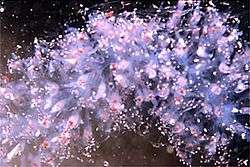Apolemia uvaria
| Apolemia uvaria | |
|---|---|
 | |
| Scientific classification | |
| Kingdom: | Animalia |
| Phylum: | Cnidaria |
| Class: | Hydrozoa |
| Order: | Siphonophorae |
| Suborder: | Physonectae |
| Family: | Apolemiidae |
| Genus: | Apolemia |
| Species: | A. uvaria |
| Binomial name | |
| Apolemia uvaria (Lesueur, 1815) | |

Apolemia uvaria, commonly known as string jellyfish, barbed wire jellyfish,[1] and "long stringy stingy thingy",[2] is a siphonophore in the family Apolemiidae.[3]
As with all siphonophores, string jellyfish may appear to be a single organism, but each specimen of Apolemia uvaria is a colony of specialised minute organisms called zooids. All the zooids are attached to each other and are physiologically connected to the extent that they cannot survive alone.
String jellyfish are colonial animals that may reach 3 m in total length and have a diameter of 2–5 cm. The colony is formed of a central string, bearing groups of pink and white tentacles, which clump together or extend. The whole colony has a gas float at the front and a set of swimming bells.[4] This colonial animal is pelagic and is found in oceans worldwide in midwater.[4] These ocean predators act like drift nets, spreading their tentacles to catch plankton. The tentacles give a painful sting and are best avoided.[2][4]
References
- ↑ Jones, Georgina. A field guide to the marine animals of the Cape Peninsula. SURG, Cape Town, 2008. ISBN 978-0-620-41639-9
- 1 2 Staff, Te Ara, The Encyclopedia of New Zealand. http://www.teara.govt.nz/en/corals-anemones-and-jellyfish/page-1 Accessed 16 Sept 2013
- ↑ http://marinespecies.org/aphia.php?p=taxdetails&id=135497 accessed 8 September 2013
- 1 2 3 Wrobel D. & Mills C. 2003. Pacific Coast Pelagic Invertebrates: a guide to the common gelatinous animals. Sea Challengers. ISBN 0-930118-23-5
| Wikimedia Commons has media related to Apolemia uvaria. |